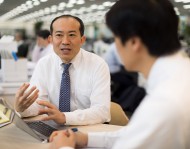Guide to Investing in Japan
Japan is changing in significant ways, which is having a strong positive impact on the country’s long-term growth potential. Read this guide to learn why and how we believe you should consider gaining exposure to Japan.
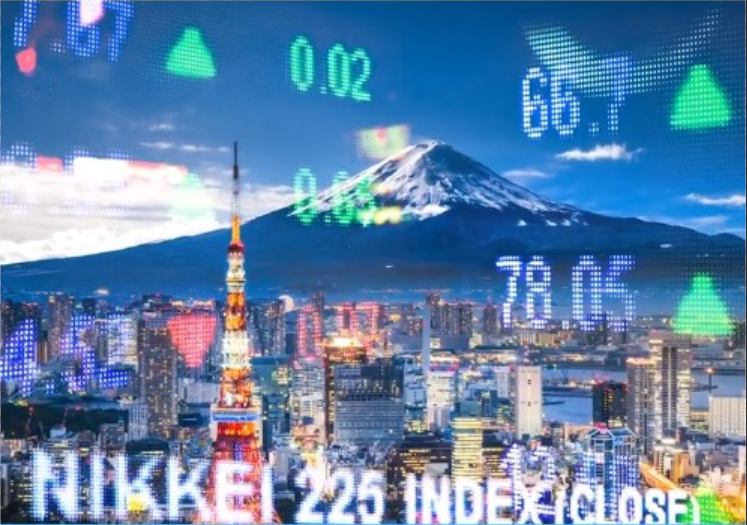
Significant policy and structural reform initiatives are shaping future economic growth. Key areas of change in Japan are:
- Improved corporate governance: Government-led reforms have caused companies to focus more on shareholder returns.
- Labor/culture reforms: To compensate for a shrinking workforce, new policies have brought more immigrants, women, and retirees into the workforce, and the practice of lifetime employment is starting to fade.
- Demographics-driven innovation: An aging population and low birth rates have spurred innovation in industries such as factory automation, robotics, and healthcare.
These macro-level changes and a stable political environment, combined with attractive valuations, make Japan an excellent investment opportunity.
Explore Our Guide to Investing in Japan:
Top Reasons to Consider Investing in Japan
1. Abenomics provides a foundation for growth
Before 2012, Japan had spent many years in a deflationary environment, sometimes referred to as the "lost decade”, and investment in Japan was greatly inhibited. Upon his election, Prime Minister Shinzo Abe instituted economic policies, known as “Abenomics”, which focused on weakening the yen through monetary easing and increasing inflation to 2%. Also, Abenomics included many structural reforms and fiscal reform initiatives described below.
As a result of these policies, the Japanese economy exited deflation on a sustained basis for the first time in two decades, and the return on equity (ROE) of Japanese stocks has almost doubled since 2012, prices and wages are rising, employment is rising and cap-ex has been setting new highs.
2. Compelling valuations
As seen on the charts below, Japanese stocks are trading at compelling valuation levels compared to other developed equity markets around the world and relative to their own historical averages, offering another reason to consider purchasing Japanese mutual funds.
- Attractive Price-to-Earnings Multiple
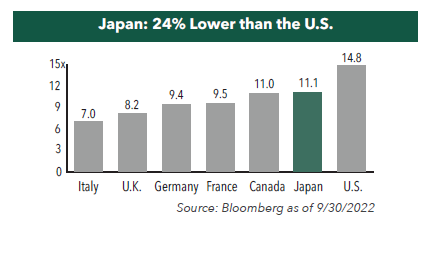
- Low Price-to-Book
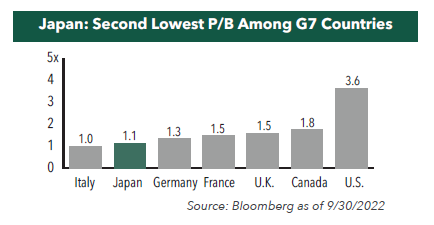
- Japan Small-Caps at a Discount
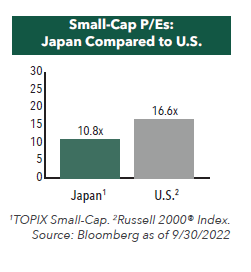
- Attractive P/E Relative to History
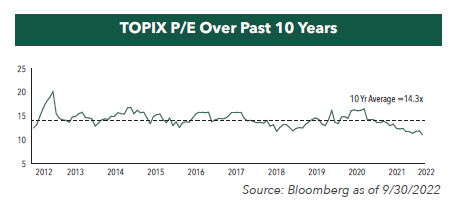
Learn more about current Japanese valuations
3. Improved corporate governance
A primary focus of Abenomics’ structural reform was corporate governance, which put more focus on shareholder returns and included the initiation of Japan's "Stewardship Code." This has resulted in higher shareholder dividend payouts, increased shareholder activism, higher corporate profit margins, and higher returns of equity for many Japanese companies.
4. Stable, pro-growth political environment
The combination of Japan’s reform-minded, pro-growth government and pro-business, pro-inflation central bank has provided a strong impetus to economic growth. Prime Minister Shinzo Abe, who resigned in August due to health issues, was succeeded by his close ally and chief cabinet secretary, Yoshihide Suga. Prime Minister Suga is expected to continue his predecessor's policies with economic growth as the priority. Japan has enjoyed a stable political environment, which makes it likely that the current pro-growth policies will remain in place over the coming years.
5. Labor reforms and cultural shifts offset a shrinking workforce
To help offset the national labor shortage brought on by the decline in Japanese workers, a recent suite of labor reforms were enacted. A new visa system was introduced to bring in more foreign labor, underfunded pensions encouraged retirees to continue working, and Abenomics’ child care initiatives brought almost two million more Japanese women into the labor force since 2012.
Beyond government-mandated policies, corporate culture in Japan is also modernizing. The days of Japan, Inc’s rigid, closed corporate culture and “lifetime employment” are starting to fade as companies move toward a more merit-based system.
6. Rising profitability
Japanese corporations are catching up with their Western counterparts in profitability, with their return on equity (ROE) rising due to innovation, cost-cutting, and growing export sales. In 2018, the ROE of the Tokyo Stock Price Index approached 10% for the first time since the great financial crisis. While that level has declined in recent months, we view this as a temporary setback because of the continuous improvement in corporate governance and a strong focus on ROE.
With a benign currency environment and low interest rates, Japan’s ROE is expected to rebound, potentially rising above 10% and closer to levels achieved in Europe and the U.S.
7. High-quality, globally-oriented companies
There are many high-quality, globally-oriented companies with able management in Japan that are protected by high barriers to entry. The stocks of these companies provide investors with growth opportunities around the world, including exposure to developing countries. However, Japanese companies generally offer more transparency, better corporate governance, and higher liquidity than companies domiciled in emerging markets. This makes investing in Japan through mutual funds that carefully select these companies an attractive long-term investment opportunity.
8. Demographic factors driving innovation
An aging population and low birth rates may be seen as negative factors for future growth. But in Japan, these demographic trends are a driving force behind the emergence of Japanese companies with high growth potential. This is because necessity has been the mother of innovation. For example, new solutions are required for citizens who are living longer and healthier lives, which has spurred a boom of innovation in the healthcare industry. And new solutions are required for the lack of available labor force, which has helped fuel Japanese innovation and leadership in robotics and factory automation, as highlighted below.
9. Global leadership in robotics and automation
Japan is an undisputed leader in the production of factory automation systems and robots. Five of the top 10 producers in the world are in Japan and these companies possess nearly 30% of the worldwide market share. Japanese automation and robotics companies are currently benefiting from strong demand growth for their products. For example, worldwide sales of industrial robots have grown six-fold in less than a decade, and Asia is by far the world’s largest end market for factory automation products.
Learn more about Japan’s factory automation revolution.

Current Outlook for Investing in Japan
"We believe the Hennessy Japan Fund is well-positioned as the portfolio is built around Japan's manufacturing excellence."
- MASA TAKEDA
The Japan Fund is invested in companies that demonstrate Japan’s manufacturing excellence and high-quality craftsmanship along with asset-light technology businesses. Read our Sector Highlight: Japan's Most Durable Advantage
With many challenges facing global investors, we asked Masa Takeda, Portfolio Manager of the Hennessy Japan Fund to provide his insights. In our latest manager commentary,he shares his views on the Japanese market, how the Fund is positioned to take advantage of "growth in disguise" companies, and why investors may want to consider Japanese equities for the long term. Here are the key takeaways:
• Japan has begun to slowly reopen to overseas tourists. While the Fund has no direct exposure, we believe new holding ORIX Corp. could be an indirect beneficiary.
• Many Japanese exporters have benefited from the Yen depreciation, yet investors have not rewarded these exporters equally.
• Japanese companies look attractively priced compared to U.S. companies, with the Tokyo Stock Price Index trading at 12.2x 2022 estimated earnings as of September 6, 2022, compared to 17.3x for the S&P 500® Index.
• We believe new holding Tokio Marine, Japan’s largest general insurance group, is an example of a “growth in disguise” company that has compelling growth prospects but the stock is valued at what we believe to be a low price to earnings multiple.
• Despite macro challenges, we believe it’s important to focus on individual market-leading companies that are well run and globally competitive.
Read our latest portfolio manager commentary Investing in "Growth in Disguise" Japanese Companies


How to Invest in Japan
Individual Japanese stocks
A common approach for investing in Japan is to purchase shares in publicly held Japanese companies. While these investments are highly liquid and give you total control over the companies you invest in, this approach has significant drawbacks. Building a portfolio of individual stocks requires extensive research into each company you invest in, and you need to buy several individual stocks to diversify. Plus, you may have to pay a commission each time you buy or sell.
Japanese Mutual Funds
Japan mutual funds (also known as equity funds) represent a portfolio of investments in stocks of companies that are located in Japan and can cover a wide range of market caps, sectors, and styles. The funds can be passively or actively managed by teams that are based in Japan or remotely.
We believe one of the best ways to take advantage of Japan’s future growth potential is by investing in Japanese stocks and mutual funds.
-
Passive vs. Active Management
Mutual funds can be passively or actively managed. While passively managed (or index) funds and ETFs can offer some advantages such as lower fees, it can sometimes be difficult to capitalize on the best opportunities through index funds, particularly in Japan. This is because most Japanese index funds and the Tokyo Price Index (TOPIX), Japan’s major stock index, are dominated by traditional, slow-growing behemoths — not the nimble, globally competitive companies that make investing in Japan an attractive opportunity.
To maximize Japanese investment opportunities, we believe you should choose active, rather than passive, Japanese mutual funds. Active managers perform in-depth, company-specific research to build a portfolio of Japanese companies they believe can outperform due to their business model, management team, balance sheet strength, competitive moat, or product advantage.
-
Importance of In-Country Management
Japan remains a mystery for many U.S. investors. Japan’s language and corporate culture are very unique, and we believe the best way to access the market is by active investment management with in-country managers and research teams that understand the nuances of the Japanese language and corporate culture and have decades-long relationships with Japan's company management. This way, portfolio managers truly understand the inner workings of Japanese companies and the market as a whole and can correctly interpret and translate research into winning investment ideas.

Plus, due to job rotation programs in Japanese financial institutions, there is a lack of professional, tenured, institutional investment managers in Japan.
While data on large-cap Japanese companies is readily available, many smaller companies lack research. Being located in Asia allows for local research, where portfolio managers and analysts can visit offices, plants, stores, suppliers, and customers in the region to gain direct, on-the-ground insights. This helps portfolio managers uncover real-time information about current investment opportunities that might go undiscovered without a local presence.
Selecting Japan Mutual Funds
We encourage investors to compare all available funds to find the best Japanese mutual funds that match their investment objectives. Hennessy Funds offers two funds, both highly rated by Morningstar: the Hennessy Japan Fund and Hennessy Japan Small Cap Fund. To view the Morningstar ratings, please click here.
We believe Japan’s growth story is just starting to unfold and that active management with a local presence provides a critical advantage for investors interested in Japan. Both of the Hennessy Japan funds offer the opportunity to invest in the potential rebound of the Japanese economy. Here are a few highlights for both funds:
- Actively managed, concentrated portfolios. Through intensive, fundamental research, the portfolio managers limit investments to their best ideas, to give the best opportunity to outperform the market over the long-term.
- In-country teams. Based in Tokyo, our team has decades-long familiarity with Japan’s business landscape and unique corporate culture, which allows them to analyze day-to-day research and translate insights into winning investment ideas. Managers have access to real-time information about specific companies and investment opportunities, instead of relying on second- or even third-hand research and data.
- Sound, proven investment criteria. Our portfolio managers focus on sustainable growth while limiting the downside by seeking Japanese companies with exceptional management, well-capitalized balance sheets and minimal debt, high ROE, strong cash flow, above-average earnings growth rate that’s sustainable and predictable, with a durable competitive advantage and compelling valuations.
- Long-term, high-conviction strategy. The Hennessy Japan Fund managers invest with a long-term horizon and maintain positions in stocks that they are confident can outperform over market cycles.
Frequently Asked Questions About Investing in Japan
Here are a few questions we often hear about investing in Japan:
Is Japan a good investment?
The economic policies often referred to as Abenomics have ended decades of deflation and are supporting strong economic growth in Japan. The return on equity (ROE) of Japanese stocks has nearly doubled since Abenomics, and Japanese equities offer tremendous growth potential compared to other foreign nations, which makes investing in Japan attractive.
How do I invest in Japan?
A good way for individuals to invest in Japan is to purchase shares in Japanese mutual funds. To maximize Japanese investment opportunities, you should choose active, rather than passive, mutual funds. In addition, Japanese mutual funds should have feet-on-the-street research capabilities to uncover the best Japanese investment opportunities.
How can U.S. investors access Japanese equities?
U.S. residents, including those living overseas, can invest in Japan by purchasing shares in Japanese mutual funds that are registered for sale within the U.S. The Hennessy Funds are specifically designed to allow U.S. investors to easily invest in the Japanese market.
Is the Japanese stock market undervalued?
Japanese equities are currently trading at compelling valuation levels compared to the U.S. and other markets around the world and relative to their own historical averages, making investing in Japan attractive.


